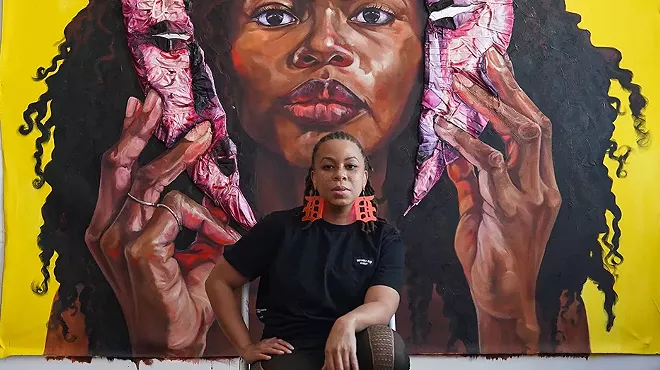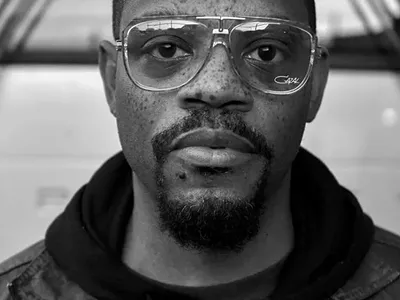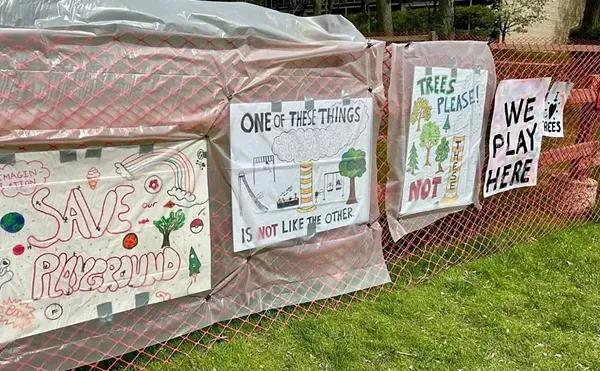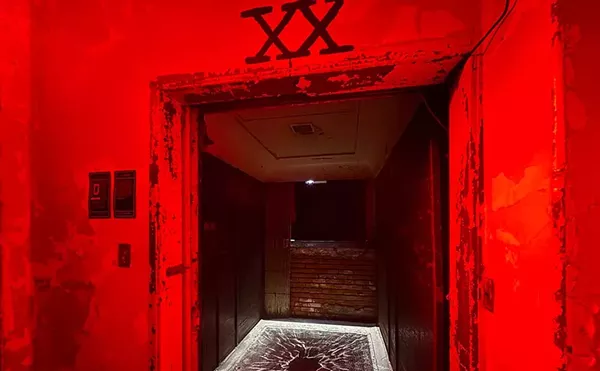Sydney G. James’s BLKOUT Walls festival has its second go with international artists
These painters of color aren’t ‘marginalized’ — they’re resilient

Audio By Carbonatix
[
{
"name": "GPT - Leaderboard - Inline - Content",
"component": "35519556",
"insertPoint": "5th",
"startingPoint": "3",
"requiredCountToDisplay": "3",
"maxInsertions": 100,
"adList": [
{
"adPreset": "LeaderboardInline"
}
]
}
]
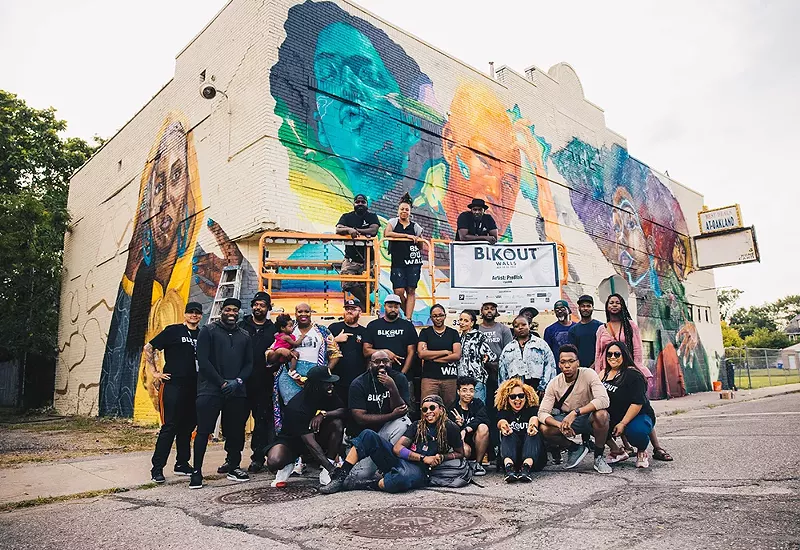
When Detroit painter Sydney G. James first launched the BLKOUT Walls mural festival in 2021, people weren’t quite sure what to expect.
Many Detroiters were likely familiar with James’s work, including her popular “Girl with the D Earring” mural on the Chroma building, but she was planning to bring an entire festival of mostly painters of color to decorate the nearby North End neighborhood. Securing funding and walls for the artists to paint was like pulling teeth, she remembers.
But after James and the crew of artists completed their murals — a tribute to the late J Dilla’s Donuts, Black women with the entire universe in their fros included — the city knew it had something undeniably remarkable on its hands. We waited with bated breath for BLKOUT Walls festival to return to the streets of the city, and two years later, James is ready to do it again.
BLKOUT Walls is set for Sept. 7-17, where you’ll be able to watch muralists paint their pieces live. Seeing how the murals take shape day to day is half of what makes it fun to watch. Artist talks are scheduled throughout the ten-day festival and the whole thing ends with a huge block party at Chroma.
For its second installment, BLKOUT Walls has gone international as it welcomes Jamaican artist Taj Francis and Mohammed Awudu from Ghana.
They’re joined by Sheefy McFly, Miah the Creator, Jason Garcia, Bakpak Durden, Habacuc S. Bessiake, Birdcap, Cailyn Dawson, and Darius Baber, among others.
The second installment of BLKOUT Walls was supposed to be held in Oakland, California in September of 2022, but James says the funding fell through. This time around, back home in Detroit, money and resources weren’t a problem, as James had already proven what she was capable of curating. Now she counts the Kresge Foundation, the City of Detroit’s City Walls program, and the Knight Foundation as sponsors.
“We showed out, honey,” she says of the 2021 festival. “Now people see what we did and they’re coming to me with money. And not just money, they’re asking ‘How can I support you?’ … The first festival did so well that business owners came to us this time to loan out their walls. I feel like we created something special and the community is really excited.”
As James was finishing one of several of the pieces she did during the 2021 festival, she says the owner of the Turkey Grill approached her and offered his business as a site for a future mural. So this year, James will be painting it in collaboration with fellow Detroit artist, and one of James’s many mentees, Ijania Cortez.
The pair started painting their wall on the longtime turkey-themed takeout spot and plans to wrap it up before the festival starts so James can be free to help the other artists as needed.
While the first BLKOUT Walls was confined to the North End area, this year’s imprint will stretch along Woodward Avenue from Midtown to Highland Park. Artists will paint the M-1 Rail Penske Tech Center (where the QLine starts before Grand Boulevard), a DTE substation, and several businesses like the New Center Supermarket at the corner of Woodward and Seward.
James created the festival after being frustrated with the lack of Black representation in other festivals like Murals in the Market (now Murals in Islandview) in which she participated for several years, often as the only Black woman in the lineup, she says.
“The first festival did so well that business owners came to us this time to loan out their walls. I feel like we created something special and the community is really excited.”
tweet this
“Public art is a two-way conversation,” she says. “Whether you think it or not, you are being a servant to the community when you put anything in the public. When you go into a gallery or museum, that’s your choice, whereas [with] street art, your audience is whoever lives in the area and whoever's visiting the area. The reality of Detroit is, it’s 85% Black… it’s a true disservice to the community and city when you just do a takeover and there’s no conversation or nothing reflective of anything culturally relevant that the people who actually live there care about.”
More than just representation, James says she’s most excited for the opportunities that BLKOUT Walls creates for emerging artists to grow. For many younger artists participating, BLKOUT Walls may be the first time they’ve painted a mural.
“All most of us need is just opportunity and street art is one of the best art schools I’ve ever attended,” James says. “You get to learn. People share their techniques. If they see that you can do something better, they’re gonna offer it to you in a loving way, and they’re gone show you [how]. They’re not just gone say, ‘Ew, that’s ugly.’ They’ll be like, ‘If you hit the [spray paint] can at this angle you might be able to see what you need better.’ To be able to share that with younger artists is a blessing.”
Habacuc S. Bessiake is one of those young artists James is talking about. Bessiake painted his first-ever solo mural at the first BLKOUT Walls, even though he didn’t originally plan on participating. At the time, he had graduated from the College of Creative Studies three months prior, and had just met James earlier that summer. He had been painting group murals since he was in high school and James was impressed with his sketchbook.
When he came to the festival to see James in action, she told him to find Joe Cazeno (aka Cashiesh), who was painting a piece on Oakland Avenue, to see if there was any wallspace open.
“I went and showed him my sketchbook and he was like, ‘Oh, you’re dope!’” Bessiake remembers. “The next day I got a text from Sydney like, this is your wall.”
Bessiake painted “A Leap of Faith” of a character that looks very much like himself jumping through the air at 7615 Oakland Ave.
“It felt like a time where I was making a big leap of faith to do the mural and to be a part of the whole of the festival,” he says, reflecting. “In 2021, I was at a point where I did not know exactly what I was going to do. I [studied] illustration, so I was supposed to be a children’s book illustrator.”
And yet, here he is painting murals. Bessiake’s work tends to have a childlike air with a sense of play, which he will be bringing to this year’s festival as well. BLKOUT Walls’ theme for 2023 is “resilience” so Bessiake is painting the city of Detroit as a bounce house on the M-1 Rail center.
“It’s gonna be literally, children bouncing off of the city, kind of around the concept of bouncing back,” he says. “With my work I’m trying to push joy, prosperity, but also growth… The city is definitely bouncing back from some kind of reset.”
Bakpak Durden, who is also participating in the festival for the second time, wouldn’t tell us exactly what they plan on painting this year, and would only say it’s something they could only do for BLKOUT Walls.
“This design that I’m conceptualizing, I’ve been thinking about it for years,” they say. “This is one of those festivals where you have free artistic reign. A lot of commissions, you’re working off what their vision is of what they want on the wall. That’s probably one of the best benefits of the festival is that you get paid to paint what you want.”
Durden, a close friend and another artist who James has taken under her wing, has also participated in Murals in the Market and painted several pieces around the Detroit area. What sets BLKOUT Walls apart, they say, is that it’s not only Black-led, but women-led.
“It’s very maternal,” they say. “There’s a consideration and there’s compassion integrated into the programming. It’s coming from a place of access, and making sure that everyone is living their best life, everyone can shine, and that it's gonna be fun… We as artists, are more likely to [want to] participate in something that we feel cared for within and throughout.”
Their piece this year will be at 12521 Woodward Ave. in Highland Park.
Sheefy McFly is participating in both BLKOUT Walls and Murals in Islandview, helmed by 1XRUN this year, which announced it will pay all participating artists for the first time this year. He chimes in that both festivals are working to beautify Detroit from different perspectives.
“Sydney’s a painter so she’s thinking from both an artist and a Black Detroiter’s aspect to show that this is a career for us and we’re speaking to our own people as the blackest city in America,” he says. “Murals in Islandview has all Detroit artists on this one. It’s evolved to a place where they can really do something cool. I got love for Sydney James and I got love for 1XRUN.”
McFly will paint a shipping container outside of Chroma.
BLKOUT Walls schedule
Tuesday, Sept. 12Artist Talk: Future of Street Art
7 p.m.; Chroma, Chroma, 2937 E. Grand Blvd., Detroit
Wednesday, Sept. 13
Artist Talk: Women on the Walls
7 p.m.; Chroma, 2937 E. Grand Blvd., Detroit
Thursday, Sept. 14
Artist Talk: The Business of Art
7 p.m.; Chroma, 2937 E. Grand Blvd., Detroit
Sat, Sept. 16
BLKOUT Block Party
Live DJs, vendors, food trucks, meet and greet with the artists
11 a.m.-5 p.m.; Chroma, 2937 E. Grand Blvd., Detroit
He adds, “Sydney the G.O.A.T. She really the only artist that learned how to do this around the world and brought it back to Detroit by creating her own festival.”
Always one to extend the olive branch to her fellow artists, James again emphasizes that the festival’s goal is not to make herself the center of attention, though there’s little that can stop her starpower from shining. It’s to give young artists of color opportunities they haven’t been getting until now.
“Mind you, Ijania and Bakpak, their first [mural] was in 2018 and look how far they've come,” James says. “If I can plant even these tiny seeds and watch them blossom, that feels good.”
Even though BLKOUT Walls is a festival featuring mostly painters of color, James says she hesitates to use the word “marginalized” when referring to these artists. Instead, she refers to them as “resilient.”
“Are there attempts to marginalize me? Sure. But they don’t matter because we go around them,” she says. “You don’t have to describe me as marginalized. I went to [a] whole ass art school, and whatever I get, I give away. Even the people around me that you’re trying to marginalize aren’t marginalized because I give them access if I’m able to do so. So resilient is something that we are because we have to be. Now, I’m tired of working out of resilience, but maybe the more we do this, the less we have to work out of resilience.”
As a final thought, she adds, “I feel like a Detroit characteristic is to prove people wrong. Like, alright fuck it, I’ll go around you and Imma do it anyway.”
Subscribe to Metro Times newsletters.
Follow us: Google News | NewsBreak | Reddit | Instagram | Facebook | Twitter

